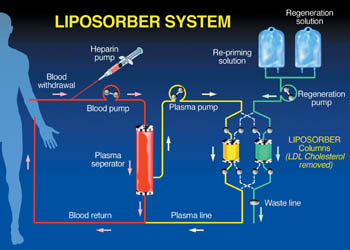
New treatment at VUMC lowers cholesterol levels
Danielle Lamb’s cholesterol was once dangerously near 1,000 — five times higher than healthy cholesterol levels which usually run under 200. Three years ago, she underwent triple bypass surgery. Danielle is not a typical heart patient; she is just 11 years old.
Every other Thursday, she comes to the Dialysis Clinic on the 10th floor of Vanderbilt University Medical Center for treatment of familial hypercholesterolemia (FH), a genetic defect in the LDL receptor that leads to extremely high blood cholesterol levels.
The LDL receptor is the protein that clears the bad cholesterol from the blood. About one in 500 people have a genetic defect in one of their two copies of the LDL receptor (heterozygous FH). In contrast, both of Danielle’s copies of the receptor are defective (homozygous FH), a condition that affects only one in a million people.
Typically, the first line of defense in patients with high cholesterol is a low-fat diet, exercise and cholesterol-lowering medications. But for patients like Danielle and others who do not see optimal results through traditional therapies, a new treatment option is now available at Vanderbilt called LDL apheresis.
Drs. MacRae F. Linton, professor of Medicine and Pharmacology, and Sergio Fazio, professor Medicine and Pathology, were responsible for introducing the Liposorber LA-15 System to the local medical community.
“We are the first in this region to offer treatment with this device,” said Linton, director of Vanderbilt’s Lipid Clinic and co-director of Atherosclerosis Research Unit. “LDL apheresis has been studied extensively in Europe, and it has recently become available in the United States. The procedure is like dialysis for cholesterol. It selectively removes the LDL or bad cholesterol from the blood.”
Although this is not a treatment for more common cholesterol problems, primarily because of the plethora of effective cholesterol medications on the market, it will produce exceptional benefits for the select group needing the lifesaving measure, both doctors said.
It has proven beneficial in reducing heart attacks and other cardiovascular events, they said
For Lamb, the twice-monthly treatments have proven successful. Her total cholesterol had dropped by more than half with treatment with four different cholesterol-lowering medications, but her LDL cholesterol is still around 400. Treatment with LDL apheresis gets her total cholesterol below 100 and her LDL cholesterol to 60.
Although Lamb is the first patient to use the new device, Fazio expects the utilization rate to be near five to 10 patients at a time.
“This represents the only therapeutic avenue for some patients,” Fazio said. “It is a necessary addition to our treatment protocols. It certainly is an intervention that works and is an important option for people with a genetic defect or patients unable to tolerate cholesterol-lowering medications.”
Fazio describes the device as a set of pumps that draw the blood through a separator. The plasma goes into a column, “like flypaper for cholesterol, and filters through resin. What is collected at the bottom of the container is the plasma without the cholesterol. It will be given back to the patient.”
This process of filtering takes approximately three to four hours, Fazio said. He credits two very experienced dialysis nurses, Dan Majors and Billie Axllie who got the procedure up and running on the Dialysis Unit, under the supervision of Dr. Gerald Schulman, professor of Medicine.
Other patients who will benefit from LDL apheresis include those with the heterozygous form of the disease, where one gene is affected; those with coronary disease and LDL levels above 200 despite medicinal intervention; those without coronary disease with LDL levels above 300 with medical therapy and those who are not able to tolerate the medications, especially transplant patients whose drug therapy often raises cholesterol levels.
“I have seen a difference in her,” said Niki Lamb, Danielle’s mother. “Not just in the lower levels, but she is not near as angry as she was. She is a lot happier and she does a lot more.
“She is still limited about what exercises she can and can’t do because of the damage that is already done to her heart, but it was either this [treatment] or a transplant. She will have to do this for the rest of her life. This has at least slowed down the disease process.”
Because of the introduction to the new therapy, Linton said Lamb’s body is getting a much-needed rest from the effects of such elevated cholesterol levels.
“With this new treatment, she has a chance,” Linton said. “Now we are in the realm where we could see regression of the disease.”













